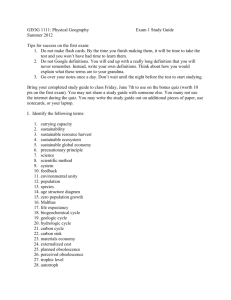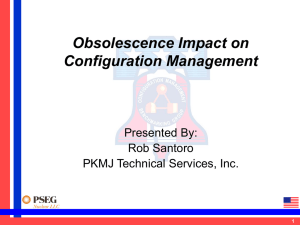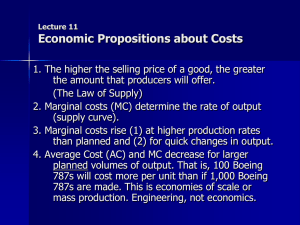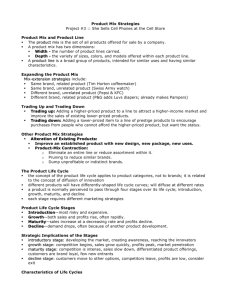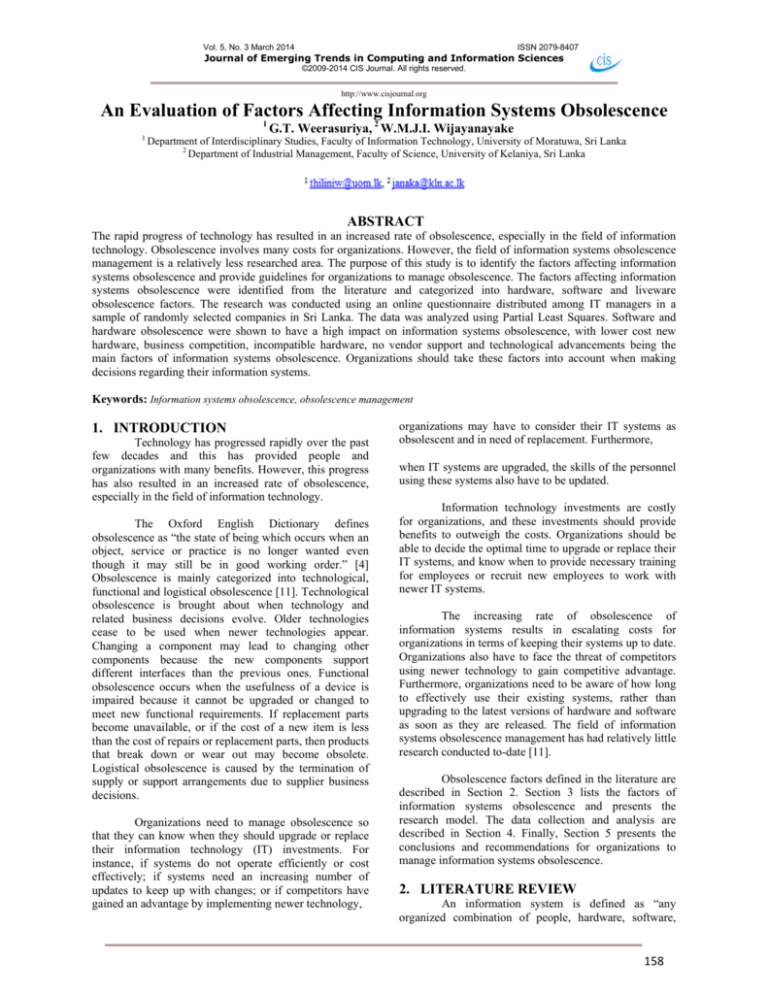
Vol. 5, No. 3 March 2014
ISSN 2079-8407
Journal of Emerging Trends in Computing and Information Sciences
©2009-2014 CIS Journal. All rights reserved.
http://www.cisjournal.org
An Evaluation of Factors Affecting Information Systems Obsolescence
1
1
G.T. Weerasuriya, 2 W.M.J.I. Wijayanayake
Department of Interdisciplinary Studies, Faculty of Information Technology, University of Moratuwa, Sri Lanka
2
Department of Industrial Management, Faculty of Science, University of Kelaniya, Sri Lanka
ABSTRACT
The rapid progress of technology has resulted in an increased rate of obsolescence, especially in the field of information
technology. Obsolescence involves many costs for organizations. However, the field of information systems obsolescence
management is a relatively less researched area. The purpose of this study is to identify the factors affecting information
systems obsolescence and provide guidelines for organizations to manage obsolescence. The factors affecting information
systems obsolescence were identified from the literature and categorized into hardware, software and liveware
obsolescence factors. The research was conducted using an online questionnaire distributed among IT managers in a
sample of randomly selected companies in Sri Lanka. The data was analyzed using Partial Least Squares. Software and
hardware obsolescence were shown to have a high impact on information systems obsolescence, with lower cost new
hardware, business competition, incompatible hardware, no vendor support and technological advancements being the
main factors of information systems obsolescence. Organizations should take these factors into account when making
decisions regarding their information systems.
Keywords: Information systems obsolescence, obsolescence management
1. INTRODUCTION
Technology has progressed rapidly over the past
few decades and this has provided people and
organizations with many benefits. However, this progress
has also resulted in an increased rate of obsolescence,
especially in the field of information technology.
The Oxford English Dictionary defines
obsolescence as “the state of being which occurs when an
object, service or practice is no longer wanted even
though it may still be in good working order.” [4]
Obsolescence is mainly categorized into technological,
functional and logistical obsolescence [11]. Technological
obsolescence is brought about when technology and
related business decisions evolve. Older technologies
cease to be used when newer technologies appear.
Changing a component may lead to changing other
components because the new components support
different interfaces than the previous ones. Functional
obsolescence occurs when the usefulness of a device is
impaired because it cannot be upgraded or changed to
meet new functional requirements. If replacement parts
become unavailable, or if the cost of a new item is less
than the cost of repairs or replacement parts, then products
that break down or wear out may become obsolete.
Logistical obsolescence is caused by the termination of
supply or support arrangements due to supplier business
decisions.
Organizations need to manage obsolescence so
that they can know when they should upgrade or replace
their information technology (IT) investments. For
instance, if systems do not operate efficiently or cost
effectively; if systems need an increasing number of
updates to keep up with changes; or if competitors have
gained an advantage by implementing newer technology,
organizations may have to consider their IT systems as
obsolescent and in need of replacement. Furthermore,
when IT systems are upgraded, the skills of the personnel
using these systems also have to be updated.
Information technology investments are costly
for organizations, and these investments should provide
benefits to outweigh the costs. Organizations should be
able to decide the optimal time to upgrade or replace their
IT systems, and know when to provide necessary training
for employees or recruit new employees to work with
newer IT systems.
The increasing rate of obsolescence of
information systems results in escalating costs for
organizations in terms of keeping their systems up to date.
Organizations also have to face the threat of competitors
using newer technology to gain competitive advantage.
Furthermore, organizations need to be aware of how long
to effectively use their existing systems, rather than
upgrading to the latest versions of hardware and software
as soon as they are released. The field of information
systems obsolescence management has had relatively little
research conducted to-date [11].
Obsolescence factors defined in the literature are
described in Section 2. Section 3 lists the factors of
information systems obsolescence and presents the
research model. The data collection and analysis are
described in Section 4. Finally, Section 5 presents the
conclusions and recommendations for organizations to
manage information systems obsolescence.
2. LITERATURE REVIEW
An information system is defined as “any
organized combination of people, hardware, software,
158
Vol. 5, No. 3 March 2014
ISSN 2079-8407
Journal of Emerging Trends in Computing and Information Sciences
©2009-2014 CIS Journal. All rights reserved.
http://www.cisjournal.org
communications networks, and data resources that stores
and retrieves, transforms, and disseminates information in
an organization.” [10]. Information systems obsolescence
can be categorized into software obsolescence, hardware
obsolescence and liveware (people) obsolescence.
2.1 Software Obsolescence
Software obsolescence occurs when software is
rendered obsolete due to a number of reasons as stated
below. The obsolescence of many commercial
applications and operating systems depends on the “end of
support” date, since the software becomes a security risk
when security patches are no longer provided by the
software vendors [11].
The reasons for software obsolescence can be listed
according to the categories of obsolescence:
Technological obsolescence: The reasons for
termination of sales and support for software are
due to the software no longer being sold by the
original vendor, being unable to expand or renew
licensing agreements, and the software no longer
being supported by the original vendor and third
parties under software maintenance agreements
[11]. Software applications also become obsolete
when they are retired from use and taken off the
market due to technology advancements and
decrease in product popularity [8].
Functional obsolescence: The functionality of the
software will become obsolete due to hardware
requirements or other software changes to the
system. Software vendors produce new software
to run on improved hardware and make older
software versions obsolete. Newer versions of
software can also make other software obsolete
[11]. Business strategies of organizations can
change and the software changes in line with the
new business strategies, causing functional
obsolescence of the software [1].
Logistical Obsolescence: Access to software is
limited or terminated due to digital media
obsolescence, formatting, or degradation [11].
2.2 Hardware Obsolescence
Obsolescence affects all types of computers,
including laptops, servers, and personal computers. It also
affects computer components and peripherals such as
processors, memory, printers, and scanners.
Over the past 20 years, hardware costs have been
reduced by one-half every two years while the density and
speed of hardware has doubled [6].The price and
computing power are greater in new computer models
than older models [6]. The value of older computers is
affected by the fact that new computers are cheaper and
have better performance. The specifications of new
computers can be improved by technical change. These
improvements in new computers can depress the value of
older computers by making them obsolete. Older
computers can become obsolete because they are
incompatible with new operating systems or software or
do not have hardware that becomes standard in new
models, although they are able to do existing tasks in an
acceptable manner. Technological change in hardware
manufacturing has significantly lowered the cost of
Random Access Memory, speed, and hard disk space. The
lower costs of computer hardware encouraged software
engineers to write programs that are more demanding on
the hardware. The limited capabilities of older computers
do not allow the newer software to run well [6].
Hardware obsolescence can be categorized
according to the types of obsolescence. The availability of
more technologically advanced hardware will create
technological obsolescence of existing hardware.
Software upgrades that do not execute correctly on
existing hardware will be a factor that creates functional
obsolescence of hardware. When replacement parts
cannot be obtained, this causes logistical obsolescence of
hardware [11].
2.3 Liveware Obsolescence
Liveware obsolescence occurs in the form of
skills and knowledge of computer hardware and software
becoming obsolescent. The extent of liveware
obsolescence can be observed by the quantity of training
and certifications available for people to learn new
hardware and software [13].
The productivity of end users and information
systems specialists is affected by skills obsolescence. IT
professionals must always upgrade their professional
knowledge and skills because their existing intellect will
become obsolete in a few years [13]. As new technology
changes, the roles of IT professionals will be constantly
changing and they must be able to adapt and be willing to
learn new skills.
2.4 Obsolescence Management Problem
The costs associated with obsolescence events
are not tracked by organizations [8]. The overall
consequences
of
not
developing
obsolescence
management strategies are difficult to measure due to this
reason.
Other than the topics of “information or digital
preservation” or termination of sales and support, little
attention has been paid in literature to software
obsolescence [11]. Most organisations employ a reactive
approach to software obsolescence management, such as
factoring in unspecified additional integration efforts or
vendor communication [8]. Software obsolescence is
tracked and managed by only a few system development
and support organisations. Concurrently managing
software and hardware obsolescence through systems
engineering approaches is rare. Obsolescence data and
information on software are not shared by any formal
organisations [11].
159
Vol. 5, No. 3 March 2014
ISSN 2079-8407
Journal of Emerging Trends in Computing and Information Sciences
©2009-2014 CIS Journal. All rights reserved.
http://www.cisjournal.org
3. METHODOLOGY
The factors affecting information systems
obsolescence and the factors affected by information
systems obsolescence were initially identified through the
literature review. An expert survey was conducted to
verify the applicability of the factors in the Sri Lankan
organizational context and identify any other relevant
factors of information systems obsolescence. The expert
survey panel comprised of four top-level information
technology managers in Sri Lankan organizations and
academia. The factors were verified through a detailed
discussion on the views and opinions of the panel of
experts and a final list of factors was compiled.
3.1 Factors Affecting and Affected by Information
Systems Obsolescence
organizations to replace or upgrade their existing software
in order to meet the new challenges brought on by
competition [1].
Changes in Business Strategies - The business
strategies change and the software changes with the new
business [1].
Mergers and acquisitions - Mergers and
acquisitions cause the software used by a business to be
changed (Expert survey). The acquired organization may
have to change its existing software if it is not compatible
with the software that is in use in the acquiring
organization.
3.1.1 Software Obsolescence Factors
The factors affecting software obsolescence are,
New operating systems - Newer operating
systems may not support older application software. This
would require the application software to be changed or
upgraded [13].
Technology advancements - Vendors create new
software due to technology advancements. Organizations
upgrade or replace their existing software with the newer
software, leading to the obsolescence of the existing
software [8].
New application software - Newer applications
may not run efficiently or at all on older operating
systems. Therefore the operating system would have to be
upgraded [13].
Low product popularity - Software applications
are retired from use and taken off the market by vendors
due to decrease in product popularity [8].
No vendor support - Vendors of software
applications do not provide support for older versions.
Lack of vendor support would cause organizations to
change their software because they would not be able to
obtain necessary updates, technical assistance, and other
support [8].
Competition in business environment
Competition in the business environment will cause
Business
competition
Changes in
business
strategies
Low product
popularity
No vendor
support
-
Different software versions - Different versions
of the same application software may be incompatible.
This would require the organization to discontinue the use
of one incompatible version, usually the older version
[13].
3.1.2 Hardware Obsolescence Factors
Hardware obsolescence is affected by the
following factors:
Technology advancements - Technology
advancements give rise to new hardware. This hardware is
marketed as being more efficient than existing hardware.
Therefore, organizations would replace their existing
Technology
advancements
Technology
advancements
Information
Systems
Obsolescence
Software
Obsolescence
Hardware
Obsolescence
Mergers and
acquisitions
New
operating
systems
New
application
software
Mergers and
acquisitions
Liveware
Obsolescence
Different
software
versions
Skills and
knowledge
No vendor
support
Incompatible
hardware
New
software
Lower cost new
hardware
Need for new
employees
Fig 1: Research model
160
Vol. 5, No. 3 March 2014
ISSN 2079-8407
Journal of Emerging Trends in Computing and Information Sciences
©2009-2014 CIS Journal. All rights reserved.
http://www.cisjournal.org
hardware with the new hardware [1].
No vendor support - Spares to support in-service
hardware become unavailable because some component is
no longer in production or is no longer in demand by the
marketplace. Therefore the entire hardware unit may have
to be replaced by the organization, in case a component
malfunctions [1].
Incompatible hardware - New hardware is
incompatible with old hardware components. This would
require the older hardware components also to be replaced
[13].
New software - Software upgrades require an
increased specification computer for the software to run
efficiently. Older hardware systems may not be able to
handle the requirements of the new software and have to
be replaced [1].
Lower cost new hardware - Hardware
replacement costs are sometimes lower than costs to
upgrade specific components. This would mean that entire
hardware systems would be replaced, rather than
upgrading the required components (Expert survey).
Mergers and acquisitions - Organizations may
have to change their hardware systems due to major
changes in the business environment, such as mergers and
acquisitions [1].
3.1.3 Liveware Obsolescence Factors
The following are the liveware obsolescence
factors.
Skills and knowledge - Employees require
training when new software applications or operating
systems are introduced to the organization, because they
have to acquire the new skills and knowledge to operate
the systems. If they do not update their skills and
knowledge, they will become obsolescent [13].
Need for new employees - When new
information systems are introduced organizations may
hire new employees to operate these systems. This may
cause the existing employees to become obsolescent if
their skills and knowledge are not up to date [13].
3.2 Research Model
Fig. 1 illustrates the research model representing
the factors affecting and affected by information systems
obsolescence. The rectangles in the figure represent the
factors or observed variables. The ovals represent the
components of information systems obsolescence or latent
variables. An arrow pointing from an oval towards a
rectangle (from a component of information systems
obsolescence/latent variable to a factor/observed variable)
means that the factor affects the component of
information systems obsolescence. e.g. Technology
advancements affect software obsolescence. The arrows
pointing from one oval to another oval mean that software
obsolescence and hardware obsolescence affects
information systems obsolescence, and liveware
obsolescence is affected by information systems
obsolescence. An arrow pointing from a rectangle towards
an oval represents a factor being affected by the
component of information systems. e.g. Skills and
knowledge is affected by liveware obsolescence.
4. DATA COLLECTION AND ANALYSIS
The data was collected through an online
questionnaire, in order to increase the ease of distribution
of the questionnaire and directly reach the participants.
The questionnaire was sent to IT managers of 65
randomly selected companies in Sri Lanka, in the areas of
apparel, banks, finance and insurance, manufacturing,
telecommunication, information technology, and services.
A total of 31 responses were received, giving a response
rate of 48%. 19.4% of the respondents were from the
apparel sector. The banks, finance and insurance sector
comprised of 22.6% of the total. Manufacturing,
information technology, and services sectors were each
16.1% of the survey sample. The remaining 9.7% of
responses were from the telecommunication sector.
The statistical tool used for data analysis was
Structural Equation Modelling using Partial Least Squares
(PLS). PLS is a well-established technique for estimating
path coefficients in structural models and has been widely
used in various research studies [2], [5]. PLS is designed
to explain variance, i.e., to examine the significance of the
relationships and their resulting R2, as in linear regression.
Using Ordinary Least Squares as its estimation technique,
PLS performs an iterative set of factor analyses combined
with path analyses until the difference in the average R2 of
the constructs becomes insignificant [12]. Once the
measurement and structural paths have been estimated in
this way, PLS applies either a jackknife or a bootstrap
approach to estimate the significance (t-values) of the
paths. Neither of these PLS significance estimation
methods require parametric assumptions. PLS is thus
especially suited for the analysis of small data samples
and for data that does not necessarily exhibit the
multivariate normal distribution [3], [12]. PLS estimates
the parameters in such a way that will minimize the
residual variance of all the dependent variables in the
model.
The PLS data analysis was done using the
software package Smart PLS (Version: 2.0.M3).
4.1 Reliability and Significance of the Results
The typical approach to reliability assessment is
the Cronbach α coefficient, which ranges from 0 to 1. The
Cronbach α values are above 0.7 for hardware
obsolescence, software obsolescence and information
systems obsolescence, which are acceptable for capturing
the dimensions [9]. The composite reliability of hardware,
software and information systems obsolescence, as shown
in Table 1, exceeded the threshold of 0.7 recommended
by [9]. The R2 values for the constructs are also
significantly high (greater than 0.7).
161
Vol. 5, No. 3 March 2014
ISSN 2079-8407
Journal of Emerging Trends in Computing and Information Sciences
©2009-2014 CIS Journal. All rights reserved.
http://www.cisjournal.org
software obsolescence, all factors except mergers and
acquisitions (0.398), new operating systems (0.463) and
incompatible software (0.414) are significant.
The outer loadings should be greater than 0.5 to
be significant. According to the calculations, all hardware
obsolescence factors except mergers and acquisitions
(0.405) are significant. The liveware obsolescence factor
need for new employees (0.443) is not significant. For
Table 1: Scale reliability and composite reliability measurements
Cronbach Alpha
0.8563
0.9020
0
0.7831
Hardware Obsolescence
Information Systems Obsolescence
Liveware Obsolescence
Software Obsolescence
If the cross-loading values for the measurement
items are greater for its assigned construct, compared to
any other construct, then the measurement items correlate
with the constructs. From the calculations, all
measurement items except mergers and acquisitions
(software obsolescence factor) and new operating systems
correlate with the constructs.
Since the PLS method makes no prior
distributional assumptions, traditional significance tests
and estimation of confidence intervals for the path
Average Variance
Composite
R2
Reliability
Explained
0.6030
0.8970
0.9427
0.4426
0.9184
0
0
0
0.7037
0.3863
0.8414
0.9153
coefficients cannot be done. However, the bootstrapping
estimates of mean, standard errors and t-statistic can be
used to test the significance of the structural coefficients
[3]. The bootstrapping technique is used in this research.
Table 2 gives the values obtained by running the
bootstrapping technique for samples of 17, in 80
iterations. At the 0.05 significance level, the hypothesized
paths of the constructs are considered to be significant (tvalue is greater than 1.96), according to the calculated
data.
Table 2: Total effects
(Mean, standard deviation, t-values)
IS
Hardware
IS
Liveware
IS
Software
Original
Sample (O)
Sample Mean
(M)
Standard Deviation
(STDEV)
Standard Error
(STERR)
T Statistics
(|O/STERR|)
0.971
0.974
0.010
0.010
99.507
0.839
0.837
0.079
0.079
10.571
0.965
0.970
0.014
0.014
68.006
When considering the t-values of the
measurement items, in the hardware obsolescence
construct, all paths except mergers and acquisitions (tvalue: 1.74) are statistically significant at the 0.05
significance level. The factor need for new employees (tvalue: 0.31) in the liveware obsolescence construct was
not statistically significant. Mergers and acquisitions (tvalue: 1.49) and different software versions (t-value: 1.64)
are the only measurement items that are not statistically
significant in the software obsolescence construct. These
four factors were removed from the research model and
the validated model was again tested using PLS. In this
model all t-values of measurement items except the skills
and knowledge factor (t-value: 0.00) of liveware
obsolescence were statistically significant. Therefore, this
factor too was removed and the model was tested again
using PLS. The t-values in the final validated model (Fig.
2) were all statistically significant.
The importance of the factors that affect
information systems obsolescence can be identified by
listing the t-values of the factors in descending order. In
the final validated model the factors that affect
information systems obsolescence in order from greatest
to least are as follows:
a.
b.
c.
d.
e.
f.
g.
h.
i.
Lower cost new hardware (Hardware
obsolescence)
Business competition (Software obsolescence)
Incompatible hardware (Hardware obsolescence)
No vendor support (Hardware obsolescence)
Technology
advancements
(Hardware
obsolescence)
New software (Hardware obsolescence)
Low product popularity (Software obsolescence)
Technology
advancements
(Software
obsolescence)
No vendor support (Software obsolescence)
162
Vol. 5, No. 3 March 2014
ISSN 2079-8407
Journal of Emerging Trends in Computing and Information Sciences
©2009-2014 CIS Journal. All rights reserved.
http://www.cisjournal.org
Business
competition
Changes in
business
strategies
Low product
popularity
No vendor
support
Technology
advancements
Software
Obsolescence
Technology
advancements
Information
Systems
Obsolescence
Mergers and
acquisitions
New
operating
systems
New
application
software
No vendor
support
Hardware
Obsolescence
Mergers and
acquisitions
Different
software
versions
Incompatible
hardware
New
software
Lower cost new
hardware
Fig 2: Final validated research model
j.
k.
l.
5.
New
application
software
(Software
obsolescence)
New operating systems (Software obsolescence)
Changes in business strategies (Software
obsolescence)
CONCLUSIONS AND
RECOMMENDATIONS
According to the research findings, organizations
need to consider information systems obsolescence,
taking into account software and hardware obsolescence
factors. The most important factor to be considered is
lower cost new hardware, which is the greatest factor in
hardware obsolescence. Even though the existing
hardware is functional, if a hardware component needs to
be upgraded, organizations tend to replace entire hardware
systems due to the decreasing costs of new hardware.
Organizations would have to do a cost-benefit analysis
before replacing the hardware in this manner. The main
factor that affects software obsolescence is business
competition. Organizations need to consider whether their
software applications are adequate to meet the current
business competition, and upgrade their systems
accordingly. If not, they may lose out on their market
shares and profits.
When hardware components are being upgraded,
incompatibilities may arise between the new hardware
and the existing old hardware. This fact should be taken
into consideration by organizations. The research that has
been conducted on hardware obsolescence, as mentioned
in [1], [6], [11], and the guidelines provided through this
existing research could be useful for organizations to
mitigate the risk of hardware incompatibilities. For
example, using standard hardware components, and
having agreements with hardware vendors could help
minimize the hardware obsolescence risk.
No vendor support is a factor that affects both
hardware and software obsolescence. Agreements with
vendors could help organizations mitigate the risks of this
factor of obsolescence.
Introducing new software could lead to hardware
obsolescence. This fact should be taken into consideration
when upgrading software or introducing new software. If
possible, the software should be selected which meets the
current hardware specifications, due to the fact that it
would be a waste of hardware resources if the existing
hardware has to be replaced before its time, and also if the
software is installed on hardware with insufficient
capabilities, the software will not run efficiently.
ACKNOWLEDGEMENT
The authors wish to thank the participants of the
expert survey and the respondents of the questionnaire for
their valuable input in order to successfully complete this
research.
REFERENCES
[1]
M. Bradley and R. J. Dawson, “An Analysis of
Obsolescence Risk in IT Systems”, Software
Quality Journal 7, pp. 123–130, 1998.
[2]
W. Chin, B. Marcolin, and P. Newsted, “A Partial
Least Squares Latent Variable Modeling Approach
for Measuring Interaction Effects: Results from a
Monte Carlo Simulation Study and Voice Mail
Emotion/Adoption Study”, 17th International
Conference on Information Systems, Cleveland,
pp. 21-41, 1996.
[3]
W. W. Chin, “The Partial Least Squares Approach
to Structural Equation Modeling,” in Modern
Methods for Business Research, G. A.
Marcoulides, Ed., London, pp. 295-336, 1998.
[4]
H. W. Fowler and F. G. Fowler, The Concise
Oxford Dictionary of Current English, 9th ed., D.
Thompson, Ed. Clarendon Press, Oxford, 1995.
[5]
Gefen, D. W. Straub, and M. Boudreau, “Structural
Equation Modeling and Regression: Guidelines for
Research Practice”, Communications of AIS, vol
4, article 7, 2000.
163
Vol. 5, No. 3 March 2014
ISSN 2079-8407
Journal of Emerging Trends in Computing and Information Sciences
©2009-2014 CIS Journal. All rights reserved.
http://www.cisjournal.org
[6]
M. J. Geske, V. A. Ramey, and M. D. Shapiro,
“Why Do Computers Depreciate?”, Hard-toMeasure Goods and Services: Essays in Honor of
ZviGriliches, University of Chicago Press, 2007.
[7]
F. Hitt and J. Schmidt, “Technology obsolescence
(TO) impact on future costs”, in Digital Avionics
Systems Conference, 17th DASC, 1998,
AIAA/IEEE/SAE, vol. 1, no. A33, pp. 1-7.
as an Illustration”, Technology studies: special
issue on Research Methodology, pp. 284-324,
1995.
[13]
[8]
L. Merola, “The COTS Software Obsolescence
Threat”, in ICCBSS'05, 2006, pp 127-133.
[9]
J. C. Nunnally, Psychometric theory, 2nd ed., New
York: McGraw-Hill, 1978.
[10]
J. A. O’Brien, Introduction to Information
Systems, 12th ed., New Delhi, India: Tata
McGraw-Hill, 2008.
[11]
P. Sandborn, “Software Obsolescence –
Complicating
the
Part
and
Technology
Obsolescence Management Problem”, IEEE Trans
on Components and Packaging Technologies, Vol.
30, No. 4, pp. 886-888, 2007.
[12]
R. Thompson, D. Barclay, and C. Higgins, “The
Partial Least Squares Approach to Causal
Modeling: Personal Computer Adoption and Use
J. A. Whitley, “A Study of Computer
Obsolescence and its Impact”, MSc Thesis,
Towson University, Maryland, USA, 2001.
AUTHOR PROFILES
G.T. Weerasuriya received the B.Sc. (Special) Degree in
Management and Information Technology from the
Department of Industrial Management, University of
Kelaniya, Sri Lanka, in 2011. Currently, she is a lecturer
at the Department of Interdisciplinary Studies, Faculty of
Information Technology, University of Moratuwa, Sri
Lanka.
Dr. W.M.J.I. Wijayanayake received a PhD in
Management Information Systems from Tokyo Institute
of Technology Japan in 2001. He holds a Bachelor’s
degree in Industrial Management from the University of
Kelaniya, Sri Lanka and Master’s degree in Industrial
Engineering and Management from Tokyo Institute of
Technology. He is currently a Senior Lecturer in
Information Technology at the Department of Industrial
Management, University of Kelaniya Sri Lanka.
164





